Mini UPS

Reliability and resiliency of telecommunications equipment is paramount, because according to statistics, which usually does not lie, about 80% of the failures of the equipment of telecom operators occur due to a power outage. Under the cut there is a small overview of an interesting and compact piece of iron that can keep your iron working when there is a problem with the light.
The reliability of the telecommunications infrastructure can be briefly described as such a pyramid:

In other words, the most important thing for a reliable network infrastructure is the serviceability of the environment (buildings / structures) where the infrastructure will be deployed. However, the understanding of this clearly did not reach everyone. More details can be found here , because pictures of cable chaos and ruin are found in almost every apartment house of the Soviet era.
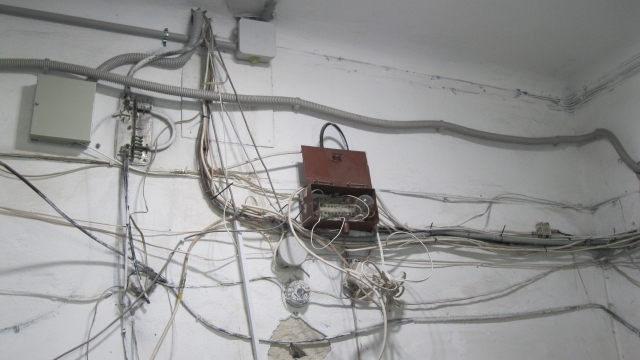
This occurs in new buildings and in respectable European provinces. (This is France, the town of Grasse, the Provence region, where the Alps, Cote d'Azur, that's all):

Or here in the same China:
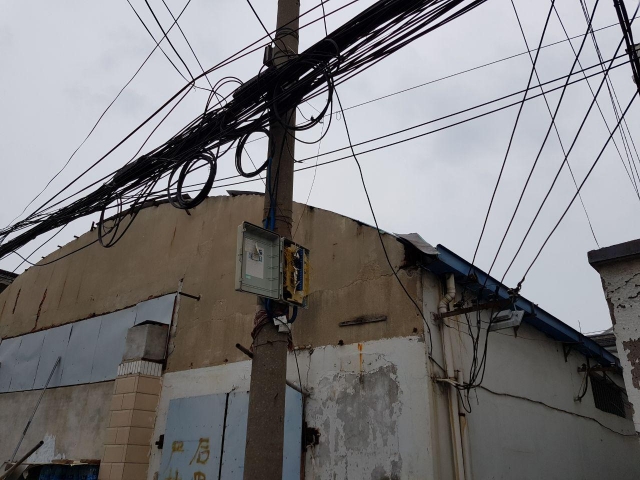
The next step in overall reliability is power supply. About 80% of failures of equipment of communication operators occur for this reason. Therefore, this is exactly the phenomenon that must be fought. The next link in the chain is the removal of heat from the cabinets with equipment or vice versa.
In general, it all comes down to communal issues, because if it is flowing from the ceiling, you first need to fix it, and only then hang up air conditioners, which in turn are powered by electricity. And here again, the notorious pyramid looms. Next is the telecommunications equipment, and on top of all this - a variety of computer hardware.
Today, I would like to tell you about the piece of iron designed to solve problems at the second level, the pyramid we painted above. A compact device called the MiniUPS only a while ago appeared on the site Shop.nag.ru ... Now it is presented in two versions:
- Power supply 12V 1A with integrated lithium-ion cell
- Power supply 5V 2A with integrated lithium-ion cell


First of all, the battery is bribed with dimensions of 100 * 50 * 68 (D * W * H) mm and weight 140 grams. At the UPS is a plug and a USB connector. And postings. And that's all. There is nothing else in the box. This is more like an ordinary tochny, power supply.
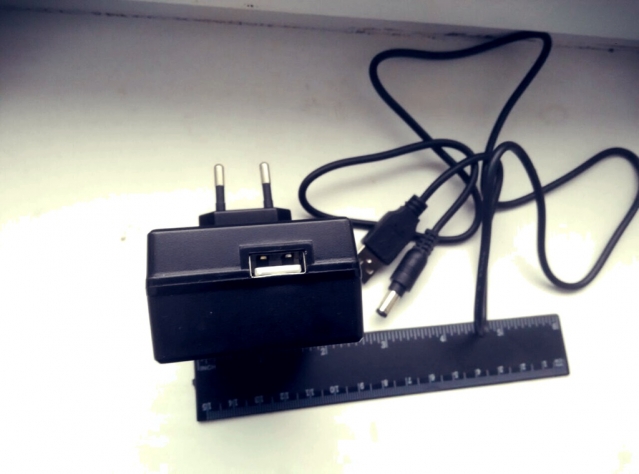
These are the electrical characteristics of the device:
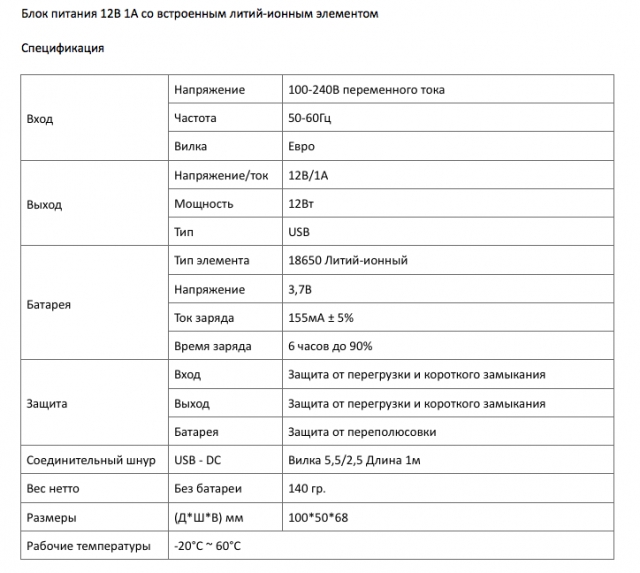
At an input voltage of 100-240 volts, the power supply will already work and can protect equipment from power surges. At the output, the device produces 12V, which means that some equipment from such a “uninterrupted power supply unit” can be powered. That current in 1A gives a power of 12 watts.
The UPS is equipped with overload and short-circuit protection at the input and output, as well as with such a battery:
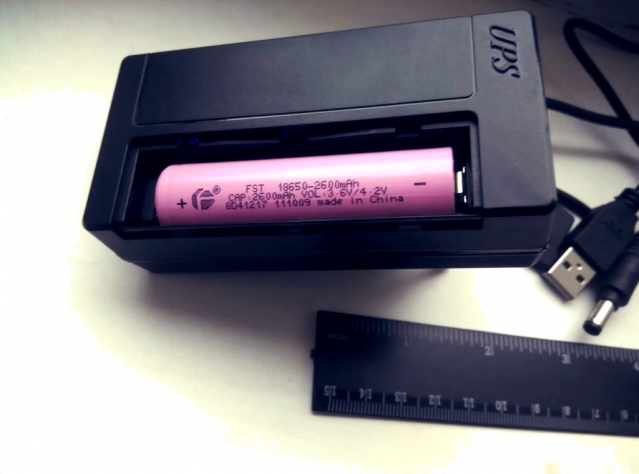
This is the famous 18650 element. He is famous for the fact that exactly the same work in the innovative and most advanced electric cars Tesla. Here is a photo of the opened Tesla battery, where you can see that it’s yes - it consists of many elements that are very similar to ours:
In fact, everything there is somewhat more complicated - cooling, a microcontroller that controls the charge of each element separately.
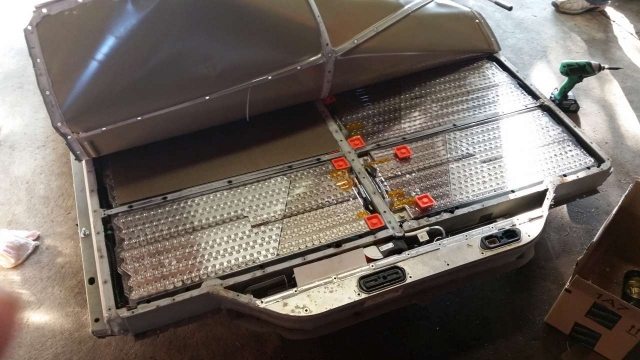
Actually, the same Gigafabrika in Tahoe and is engaged in the fact that sculpts millions of batteries and packs them into one hefty battery, which is already installed in the car.
For example, consider the inscription in Russian and remember that there is a ban on throwing electronic devices into household trash:
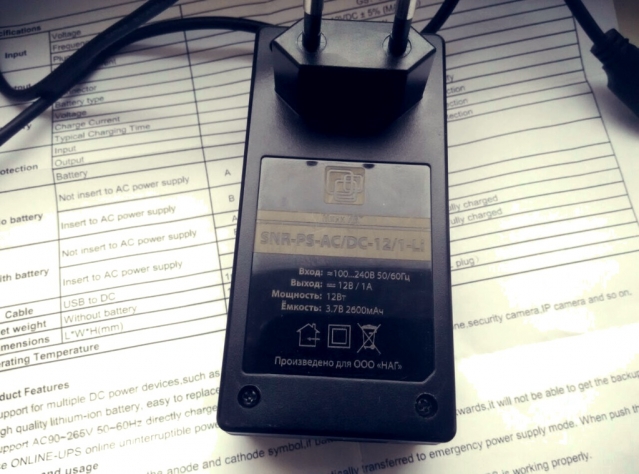
On the power supply there is a switch with the code designation "A - B":
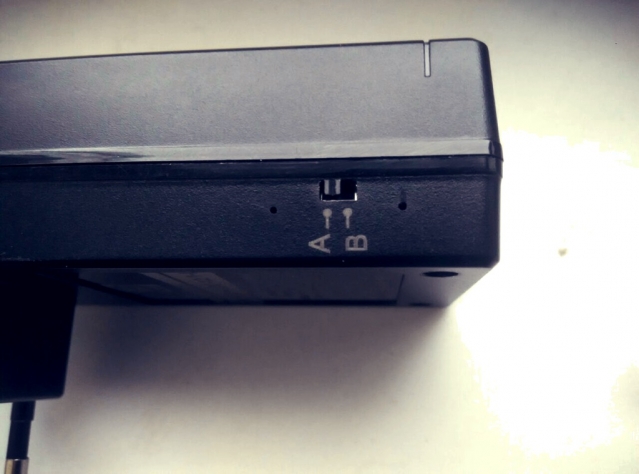
The instructions clearly state to us about the purpose of this switch:

It turned out:
- There are also several LEDs on the device. Three.
- When the device is disconnected from the network, the indicators are off.
- The device can be used in two modes:
- As a simple power supply (even without a battery)
- As an uninterruptible power supply.
With the battery installed, the device has two functions. The first is the UPS -Uninterruptible Power Supply (uninterruptible power supply) function, and the second is the ordinary power supply. Why this switch is needed, in fact, is not entirely clear, but we will not delve into the thoughts of manufacturers. Better look into the insides of the UPS.

Everything is done carefully. Even chokes, which are usually mounted with handles.
A scarf with double-sided installation turned out to be. In order for the board to SUDDENLY not to short on the 220V pins - on one side there is an insulator attached to the self-adhesive:
That's better seen:
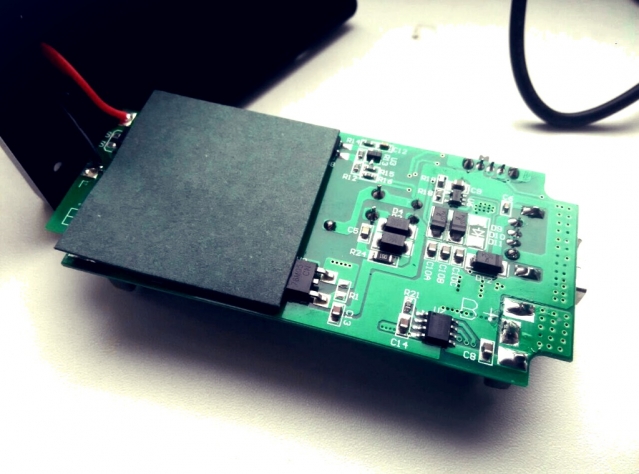

And at the same time it becomes clear why the USB connector was used. It's just that the assembler “is ready” to work with standard and familiar USB, obviously. Well, and savings.
But, by the way, in such devices is quite dangerous to use. It is very tempting to connect to charge the phone. But remember! At the exit we have - 12 volts! And not these five sickly ones that are used in USB. That is, if you still, in spite of these warnings here, connect the “telephone to charge”, then problems with the service center are guaranteed.
The price of a battery is quite a decent amount in the budget of the UPS. In this case, it is better not to save money and take the battery more expensive, but more reliable. And there is a subtlety.
Let's take a closer look at it:
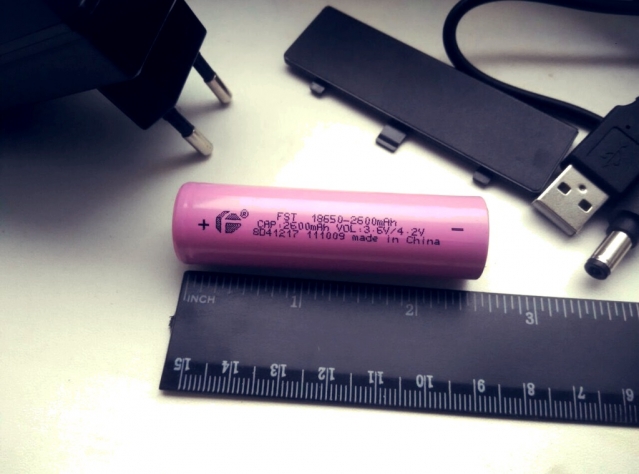
It can be seen that the battery is Chinese. You can, of course, dig and native, teslovskuyu. But then consumers may not like the price tag. FST marking is such a Chinese group of companies - FST Group. They are really big and factories for the production of any good from them - heaps. Including - two or three factories for the production of lithium-ion batteries. The production technology is Japanese. Panasonic and Sony have long been reliably transferring production to mainland China. But the Chinese would not be Chinese if they did not work with the Koreans. In general, everything is confused. I wanted to figure out what and how, but there really is a devil’s leg.
Therefore, all you need to know is the color differentiation of the pants, the labeling of the batteries. The blue ones are 1000-1500mAh, the green ones are up to 2000mAh, the sadly pink ones (as in the photo) are 2600mAh and there are still blue ones, they are up to 3000mAh.
Need to take batteries need more capacity. But the price tag on them grows nonlinearly. Optimum in terms of price / energy intensity just 2600mAh, which, in fact, Nag and delivers in the kit.
More about the 18650 type batteries, you need to know that they are “flat plus” and that some have a protection microcontroller. It is necessary just with protection, because the presence of protection against overdischarge, overcharge, polarity reversal - saves. It is unacceptable to recharge - it can literally explode due to excessive oxygen evolution and pressure build-up. Excessive discharge is also dangerous - the risk of killing the battery is high.
Protected batteries 1-2 mm longer unprotected. But such a difference does not usually interfere, although, in some particularly severe cases, you may simply not insert the battery into the container. In this case, the box is designed just for "long" batteries.
Battery parameters:
- Over current protection / short circuit - 7.5A.
- Overcharge protection - 4.25V
- Overdischarge protection - 2.75V.
- Response time - 20 ms
It should be noted that the current of 7.5 A at a voltage of 4 V gives only a 30 W load. Given that the UPS has a circuit to increase to 12 volts - almost the load must be divided in half.
This is important because not every telecom device consumes so little. And in the end, instead of bespereboynik you risk getting just an expensive power supply. The battery will not hold.
Just remember that 10-15 watts of consumption is the limit for such a small thing.
But this is enough to reliably power up some router, standing alone on a cabinet in the office.
For example, the 951st Mikrotik works quite well. hAP access points are also, for they are quite unpretentious to the input voltage, and, judging by the datasheets, they can from 8 to 30 volts. We have 12. Must work. And working:
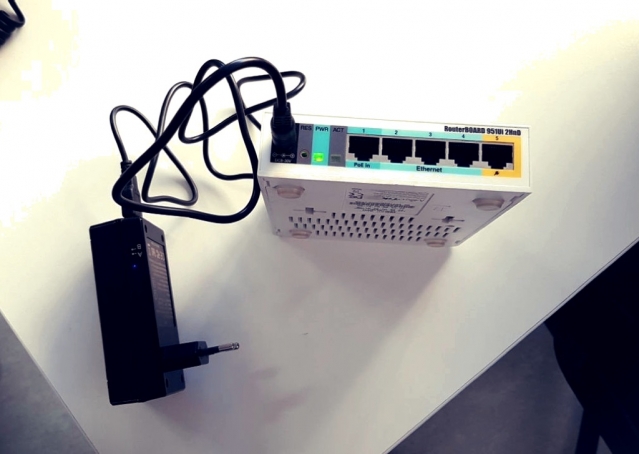
Or another device works great too.
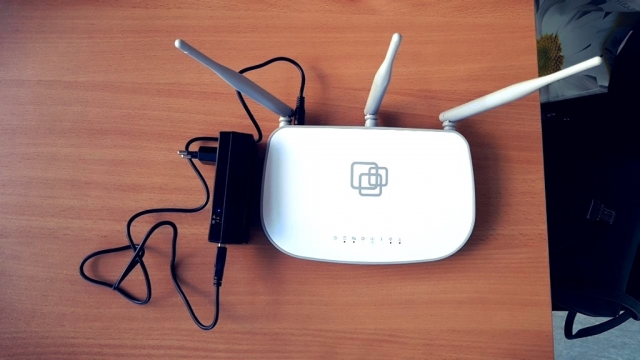
For security cameras, UPS must be a must. Well, if it comes to security. Otherwise, such cameras are disabled too simply. Test run time from full charge will not say. We were tired of waiting, and then we missed the moment. More than three hours for sure. But it works:
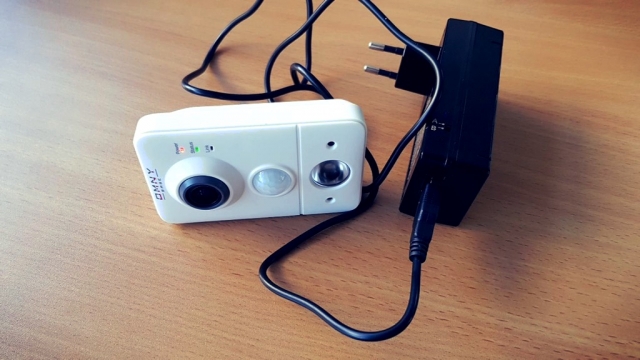
But if we connect via the PoE chain the second one is exactly the same, then, alas, the mini-UPS will no longer pull it on the battery. Just the battery turns off on protection.
And yet, with such a UPS you can power up, for example, a POS terminal. And here you can even calculate the profitability of the purchase:
- The price of UPS in retail is about 2000 rubles. But it is not exactly.
The cost of idle one hour of cash in a small outlet in the event of a voltage drop is at least 3000 rubles of lost profit, where the calculation logic is simple: let the monthly turnover be a million, divide by 30 days, divide by 12 hours of work. We get 3000 rubles.
In the year of such drops of electricity there can be more than one. It may not be.
Having the opportunity to trade at a time when no one can do this is priceless!
It remains to calculate how long the battery lasts in the case of a blackout. It's simple. Here is the formula:

where:
T is the battery autonomy time of the UPS, h;
Uakb - total battery voltage, V;
Sakb - total battery capacity, A * h;
K - inverter efficiency 0.75 - 0.85;
Kgr - the ratio of the depth of discharge of the battery 0,8 - 0,9 (80% -90%);
Kde - coefficient of available capacity (depending on the discharge mode and temperature), below are the coefficients at an ambient temperature of 20 ° C:
- with a one-hour discharge mode, 0.7 (70%);
- at the two-hour discharge mode, 0.85 (85%);
- with a ten-hour discharge mode 1.0 (100%);
Total, in our case, we get:
Uakb = 4 V (average)
Sakb = 2.6 Ah * h
K - we take for 0.75
Kgr = 0.8, at the lower limit
Kde = 0.7, at the lower limit.
Power consumption P - 7 W
4 * 2.6 * 0.75 * 0.8 * 0.7
= 4.368
4.368 / 7 = 0.624 hours. Or about 35-40 minutes.
During this time, perhaps, it can be repaired ... And there will be no interruption of work.
Prepared by: Mikhail Klimaryov
All Articles